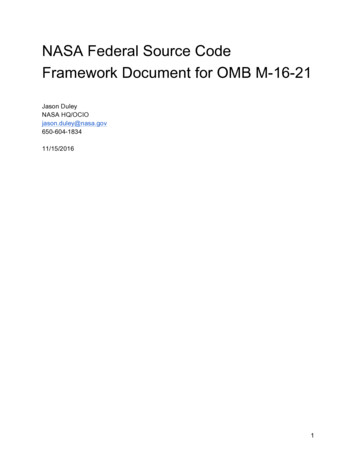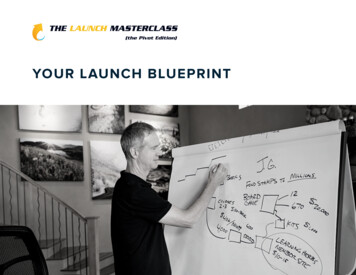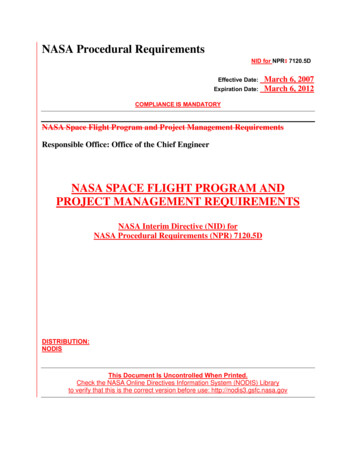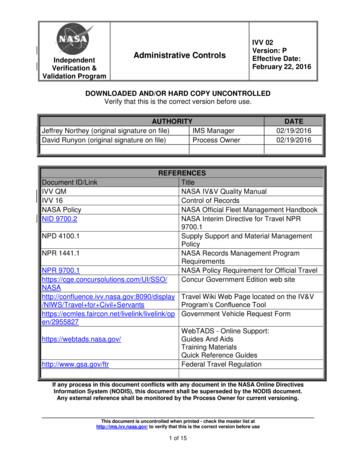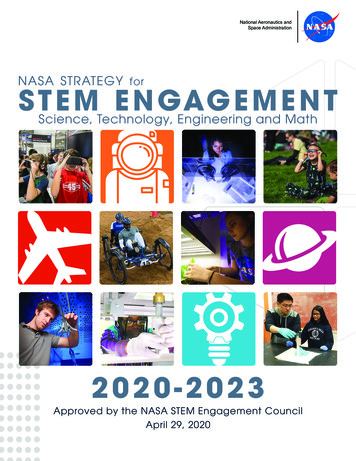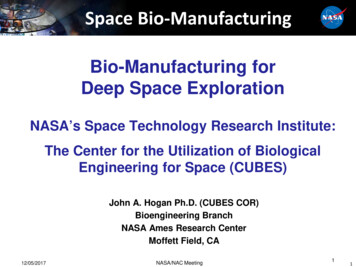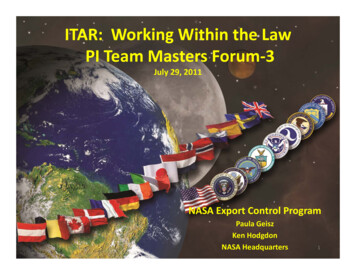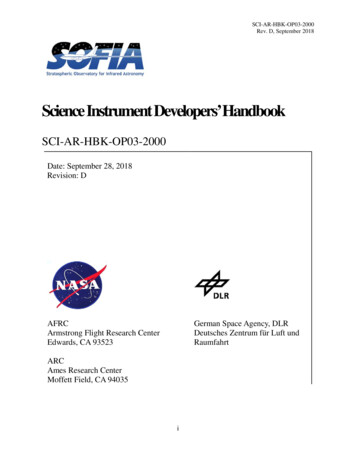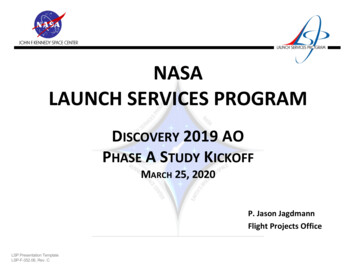
Transcription
NASALAUNCH SERVICES PROGRAMDISCOVERY 2019 AOPHASE A STUDY KICKOFFMARCH 25, 2020P. Jason JagdmannFlight Projects OfficeLSP Presentation TemplateLSP-F-352.06, Rev. C
Launch Services ProgramThe Launch Services Program (LSP) provides: Procurement and management of the launch service Technical insight/approval of the launch vehicle (LV)production/test– Mission Management and engineering support– Oversight (approval) of mission unique launch vehiclehardware/software development Launch campaign/countdown management – formalreadiness reviews Risk management for launch service Downrange telemetry assets for launch vehicle dataLSP Presentation TemplateLSP-F-352.06, Rev. C2
NASA Provided Launch Services The NASA Launch Services (NLS) II Contract is LSP’s primary method toacquire all classes of Category 2 and Category 3 commercial launch servicesfor spacecraft (SC) customers (defined on page 9) Provides NASA with domestic launch services that are safe, successful,reliable, and affordable Provides services for both NASA-Owned and NASA-Sponsored payloadsthrough multiple Indefinite Delivery Indefinite Quantity (IDIQ) Launch ServiceTask Order (LSTO) contracts with negotiated Not To Exceed (NTE) Prices Provides services on a Firm-Fixed-Price (FFP) basis––––Incorporates best commercial practices to the maximum extent practicalIncludes standard and non-standard servicesMission unique modificationsSpecial studies Allows LSP to turn on a task assignment or non-standard service at any timefor analysesLSP Presentation TemplateLSP-F-352.06, Rev. C3
Launch Vehicle Requirement This section shall demonstrate compatibility with theproposed performance level launch vehicle as definedDiscovery AOin the AO and the Program Library by providing:2019 Phase A The fairing size, spacecraft mass, launch massRequirement CS-30margin, mission orbit characteristics such as altitude,Summary(km – circular or apogee/perigee) inclination, C3,heliocentric and/or declination (DLA). Any non-standard requirements such as additionalfairing doors, cleanliness and purge requirements,planetary protection, etc., shall be described. The packaged flight system in the proposed fairing,with critical clearance dimensions, and preliminaryestimates of launch loads and structural margins shallbe included.LSP Presentation TemplateLSP-F-352.06, Rev. C4
Vehicles Projected to be AvailableUnder NLS II Most likely candidate vehicles for the Discovery AO that are projected to beavailable on the NLS II contract in the 2026/2029 timeframe are––––Antares 232Falcon HeavyFalcon 9Vulcan (ULA), New Glenn (Blue Origin), Omega (Northrup Grumman)» Vehicles expected to be on-ramped to NLS II in CY 2020– No changes to the performance classes in the Launch Services Information Summary Assumption of a specific launch vehicle configuration as part of this AO proposalwill not guarantee that the proposed LV configuration will be selected for award ofa launch service competitive procurement Bidders must remain compatible with vehicles LSP is projecting to be available onthe NLS II contract And, remain compatible with NLS II contractual capabilities and not rely on thelaunch vehicle providers users guides when determining LV configurations andperformance– Proposers are advised to plan for compatibility with all that provide their performancerequirements that are expected to be available through spacecraft Preliminary DesignReview– Payload design should accommodate the limiting/enveloping launch characteristics andcapabilities included in “Launch Services Information Summary” documentLSP Presentation TemplateLSP-F-352.06, Rev. C5
NLS II Contracts Overview Launch Services Risk Mitigation Policy for NASA-owned and/orNASA-sponsored Payloads/Missions can be found under NPD 8610.7.Document can be found at http://nodis3.gsfc.nasa.gov– Risk Category 1: Low complexity and/or low cost payloads-Classified as ClassD payloads pursuant to NPR 8705.4– Risk Category 2: Moderate complexity and/or moderate cost payloadsClassified as Class C payloads and, in some cases, Class B payloads,pursuant to NPR 8705.4– Risk Category 3: Complex and/or high cost payloads-Classified as Class Apayloads and, in some cases, Class B payloads, pursuant to NPR 8705.4 NLS II Launch Service Costs– Acquisition process begins at approximately L-36 months– Authority to Proceed (ATP) concurrent with task order award atapproximately L-30 months ( /- 3 months)» Cumulative payment of 10% due at L-30 (Nominal)» Nominal mission integration begins– Costs not covered by the Discovery Program include items such as:» Mission unique/non-standard services such as a custom/mission-specificpayload adapters, auxiliary propulsion, extreme cleanliness/contaminationsensitivities, launch services associated mission utilizing radioactive material(See Attachment 2 of the Launch Services Information Summary document)» Payload-caused launch delay costsLSP Presentation TemplateLSP-F-352.06, Rev. C6
Launch Service Budget The standard launch service includes:– Procurement and management (including risk management) of thelaunch service, technical insight/approval of the launch vehicleproduction/test and mission unique launch vehiclehardware/software development» Engineering, analysis, and minimum performance standards and servicesprovided by the contract (insight and approval)– Launch vehicle (as a service)– Launch site payload processing facility and support, logistics,hazardous support– Range support and services, contractor engineering support, basesupport contracts– Down range telemetry support (launch vehicle only)– Launch campaign/countdown management – formal readinessreviews– Mission integration managementLSP Presentation TemplateLSP-F-352.06, Rev. C7
Launch Service Budget (cont’d) The standard launch service for this AO specifically includes:– Nominal allocation for non-standard/mission unique launch vehiclemodifications/services – items typically necessary to customize the basicvehicle hardware to meet spacecraft driven requirements: T-0 GN2 purge,ISO 14644-1 Class 7 integration environment and interleaved SCtelemetry – and mission unique reviews– Launch vehicle is categorized as a high performance launch vehicle witha 5-m payload fairing for a no later than Dec 31 2026 or Dec 31 2029launch– Payload fairing with approximately two (2) nominal access doors withthermal and/or acoustic blankets (N/A to nuclear payloads)– Standard LV-provided payload separation system– Standard payload adapter (1194)– Standard test payload adapter availability– Spacecraft spin/de-spin capability for separation (if required)– Single-Spacecraft– Collision/contamination avoidance maneuver (CCAM) capability if needed– Electrical interface connectors (approximately 3 sets) Budget does not include launch delaysLSP Presentation TemplateLSP-F-352.06, Rev. C8
Launch Services Budget (cont’d) Non Standard launch services that are NOT covered under theLSP budget and cost must be included in the PI-managedmission cost (or adjusted cost cap):– Nuclear launch services utilizing a RHU/MMRTG– Enhanced contamination control, planetary protection, operationalclean enclosures– Cameras on the LV– Extended mission integration periods (in excess of 33 months)– LV hardware modifications required to accommodate unique payloadconfiguration (e.g.1666 adapter)2026 Launch Readiness Date– Less capable launch vehiclesor smaller fairings as shown:LSP Presentation TemplateLSP-F-352.06, Rev. CPerformance Class4mLow 15M toAdjusted CostCap 15M toAdjustedCost CapMediumN/A 10M toAdjustedCost CapIntermediate HighN/ANo Changeto Cost Cap5m9
Launch Service Acquisition The acquisition of the launch service will include a domesticlaunch vehicle procured and managed by the NASA/LaunchServices Program (LSP) The LSP will competitively select a launch service provider forthese missions based on customer requirements and NASA FlightPlanning Board (FPB) approval At the conclusion of the Phase A study it is recommended to havean initial draft of the Launch Service Interface RequirementsDocument (LS-IRD) which will be needed to start the launchvehicle acquisition process.LSP Presentation TemplateLSP-F-352.06, Rev. C10
Summary It is the Launch Services Program’s goal to ensure the highestpracticable probability of mission success while managing thelaunch service technical capabilities, budget and schedule Questions must be officially submitted to:P. Jason JagdmannMission ManagerNASA Launch Services ProgramCode VA-CKennedy Space Center, Fl. 32899Phone: 321-861-5748Email: Jason.Jagdmann@nasa.govLSP Presentation TemplateLSP-F-352.06, Rev. C 11
Back UpLSP Presentation TemplateLSP-F-352.06, Rev. C12
Mission Life CycleLSP Presentation TemplateLSP-F-352.06, Rev. C13
LSTO Process HQ Flight Planning Board (FPB) notifies LSP of mission requirement– Launch Services Interface Requirements Document (LSIRD) has alreadybeen developed by SC customer & provided to HQ FPB and to LSP (LSPworks with SC customer to develop LSIRD) Launch Services Program Manager notifies procurement officer ofrequirement and provides recommended technical personnel forLSTO evaluation team Procurement officer establishes LSTO evaluation team withdesignated contracting officer and lead tech evaluator– Note that the team includes up to 2 or 3 reps from the spacecraftproject team LSTO evaluation team performs the following:––––Develop tech requirements based on mission definitionAssures FAR guidelines are being followedDetermines and documents LSTO evaluation criteriaCO issues Request for Launch Services Proposal (RLSP) to multiplecontractorsLSP Presentation TemplateLSP-F-352.06, Rev. C14
LSTO Process LSTO evaluation team performs the following (cont’d):– Evaluate contractor proposals in accordance with LSTO procedures– Complete evaluation and brief to procurement officer, LSP ProgramManager, FPB, sponsoring Program/Project on evaluation results– Verify status of Authority To Proceed (ATP) Launch Services Program Manager makes selection andcoordinates with KSC Contracting Officer (CO) KSC CO awards LSTO for mission launch serviceLSP Presentation TemplateLSP-F-352.06, Rev. C15
Launch ServicesCharacteristics/CapabilitiesAppropriate fairing must be used for each performance classLSP Presentation TemplateLSP-F-352.06, Rev. C16
Payload Fairings(not to scale)4m Static Payload Fairing EnvelopeLSP Presentation TemplateLSP-F-352.06, Rev. C5m Static Payload Fairing Envelope(Low, Medium and High Performance Class)17
LSP Presentation Template LSP-F-352.06, Rev. C 2 Launch Services Program The Launch Services Program (LSP) provides: Procurement and management of the launch service Technical insight/approval of the launch vehicle (LV) production/test - Mission Management and engineering support - Oversight (approval) of mission unique launch vehicle hardware/software development
